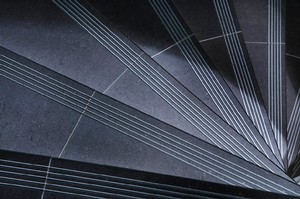Ceramic tiles used on metal
 Stringent requirements have currently been introduced on the unity of the surface to which ceramic tiles are applied, resulting in the need for applying wall and floor tiles on non-standard bases (such as steel staircases, lift cabins, etc.). As a base, metal is a very tough material for ceramics due to different expansivity characteristics compared to ceramics. For this reason, we have developed the following system:
Stringent requirements have currently been introduced on the unity of the surface to which ceramic tiles are applied, resulting in the need for applying wall and floor tiles on non-standard bases (such as steel staircases, lift cabins, etc.). As a base, metal is a very tough material for ceramics due to different expansivity characteristics compared to ceramics. For this reason, we have developed the following system:
Type of structure
- Contact bridge SE 4 + CP 203 silica sand powder
- AD 321 adhesive epoxy or hyper-flexible AD 600
- Ceramic tiles
- GE EASY or GFS epoxy jointing material
- SI silicone sealant + PES polyethylene separator
Work procedure – detailed description
Preparation: The metallic base must be rigid and well strengthened so as to prevent its deformation and flexion. The surface of metallic bases must be cleaned of all grease, all rust removed and coated with an anticorrosion product. A layer of epoxy must then be applied with the subsequent application of silica sand. In certain cases, a contact bridge based on synthetic dispersion and CP 203 mineral filler may be used. Once the material has fully cured, application of another layer may be commenced.
Installation of ceramic tiles: Two-component AD 321 epoxy adhesive, or, for less loaded surfaces, C2FT S2 grade hyper-flexible AD600 cement adhesive, may be used for ceramic tiles. Where soundproofing is required, we use the SDI sound insulation panel.
Jointing the tile surface: Once the adhesive has fully cured, we apply full-area jointing with RG grade GE EASY epoxy jointing material, or CG2 WA S1 grade GFS cement material. Approx. 0.4-0.8 kg/m2 is needed.
Sealing of flexible joints and passageways with permanently elastic sealant: Permanently elastic SI sealant must be used to allow expansion movement within the joint. If SI silicone is applied, it is recommended that PES polyethylene separators be used. They will prevent undesired adhesion to the bottom of the joint and define the exact shape of the silicone filler. Base adhesion may be increased by using Primer NP. The spreading rate of the 310 ml cartridge is approx. 6-12 bm, depending on the size of the joint.
Cleaning: Once residual cement is removed, use the CL 802 cleaning agent. Once the surface is thoroughly cleaned, we recommend that full-surface priming be applied with CL 809.
Maintenance: For regular maintenance, use CL 803 cleaning agent combined with CL 802 (scale) and CL 810 (grease).







